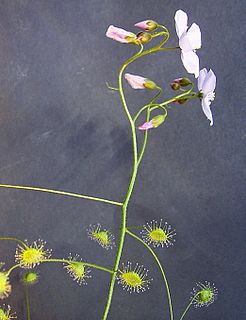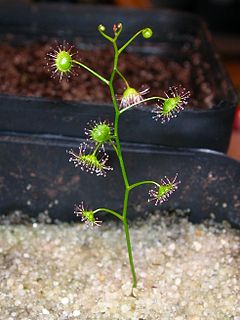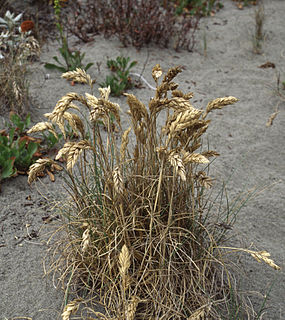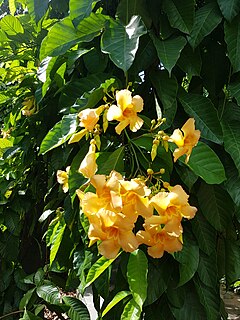Argomuellera is a genus of plant of the family Euphorbiaceae first described as a genus in 1894. It is native to sub-Saharan Africa, Madagascar, and the Comoros Islands.
Pycnocoma is a genus of plant of the family Euphorbiaceae first described as a genus in 1849. It is native to tropical Africa and Madagascar.
Dendroseris macrantha is a species of flowering plant in the Asteraceae family. It is found only in the Juan Fernández Islands of Chile. It is threatened by habitat loss.
Alseodaphne macrantha is a species of plant in the family Lauraceae. It is a tree endemic to Peninsular Malaysia.
Genyorchis macrantha is a species of plant in the family Orchidaceae. It is endemic to Cameroon. Its natural habitat is subtropical or tropical dry forests.
Myristica macrantha is a species of plant in the Myristicaceae family. It is endemic to Fiji.
Pycnocoma littoralis is a species of plant in the family Euphorbiaceae. It is found in Kenya and Tanzania.
Shorea macrantha is a species of plant in the Dipterocarpaceae family. It is a tree found in Sumatra, Peninsular Malaysia and Borneo. It is threatened by habitat loss.

Koeleria macrantha is a species of grass known by the common name prairie Junegrass in North America and crested hair-grass in the UK. It is widespread across much of Eurasia and North America. It occurs in a large number of habitat types, especially prairie.

Chaenactis macrantha is a species of flowering plant in the daisy family known by the common names bighead dustymaiden and Mojave pincushion. It is native to the Great Basin and the southwestern deserts of the United States, in California, Arizona, Utah, Nevada, southwestern Idaho, and southeastern Oregon. It grows in dry, open habitat with gravelly, sandy soils, often calcareous or alkaline in nature.

Drosera macrantha, the bridal rainbow, is a scrambling or climbing perennial tuberous species in the carnivorous plant genus Drosera that is endemic to Western Australia. It grows in a variety of habitats, including winter-wet depressions in sandy, loamy, laterite, or quartzite soils. D. macrantha produces small, cup-shaped carnivorous leaves along a long stem that can be 0.16–1.5 m (0.5–4.9 ft) high as it climbs. Its 1 in (2.5 cm) white or pink flowers emerge from June to November, blooming earlier in the more northern range.

Drosera stricticaulis, the erect sundew, is an erect perennial tuberous species in the carnivorous plant genus Drosera. It is endemic to Western Australia and is found near watercourses and granite outcrops in sandy clay or loam. D. stricticaulis produces small, cup-shaped carnivorous leaves along green, glandular stems that can be 25 cm (10 in) high. Pink flowers bloom from July to October.

Drosera sect. Ergaleium is a section of 26 species that are erect or scrambling tuberous plants in the genus Drosera. This section represents a natural group and are taxonomically monophyletic.
Monardella macrantha is a species of flowering plant in the mint family known by the common name red monardella. It is native to coastal mountain ranges of southern California and Baja California, where it grows in several habitat types, including chaparral, woodlands, and forest.

Poa macrantha is a species of grass known by the common names seashore bluegrass and large-flowered sand dune bluegrass. It is native to the west coast of North America from Alaska to northern California, where it grows in sand dunes and other beach habitat.
Acer castorrivularis is an extinct maple species in the family Sapindaceae described from a solitary fossil leaf. The species is known from the latest Eocene sediments exposed in the state of Montana, USA. It is one of several extinct species placed in the living section Macrantha.
Acer palaeorufinerve is an extinct maple species in the family Sapindaceae described from series of isolated fossil samaras and leaves. The species was described from Miocene to Pliocene aged fossils found in Japan and is known from Korean fossils and Miocene sediments exposed in the state of Alaska, USA. It is one of several extinct species placed in the living section Macrantha.

Jatropha macrantha, also called the huanarpo macho, is a medium size shrubby tree species in the genus Jatropha with orange red flowers. It is indigenous to Peru. It is as popular in Peru as Muira Puama is in Brazil.

Persea macrantha, the large-flowered bay tree, is a species of plant in the family Lauraceae. It is native to Western Ghats of India and Sri Lanka. The plant grows to about 30 m (98 ft). Leaves are simple, alternate, spiral; lamina obovate or elliptic to elliptic-oblong; apex rounded or acuminate or acute; base acute to rounded with entire margin. Flowers show terminal panicle inflorescence. Fruit is a berry where it become blackish with ripening.

Odontadenia macrantha is a vine of the family Apocynaceae native to Central and South America.












